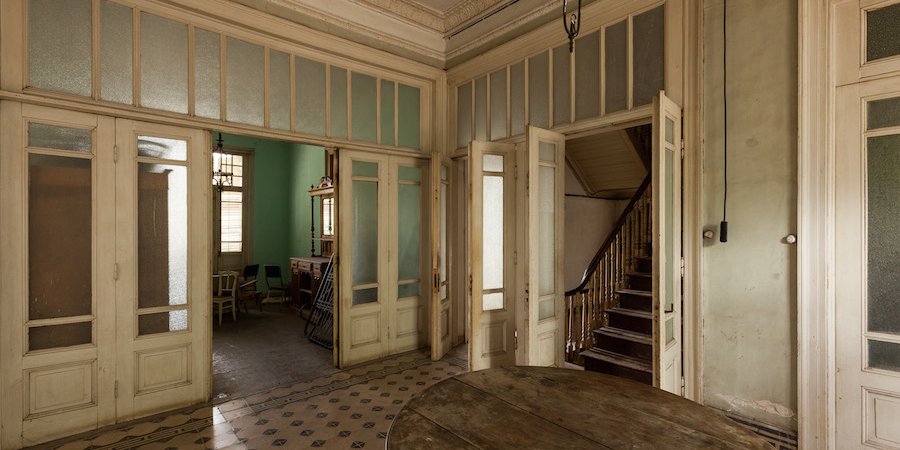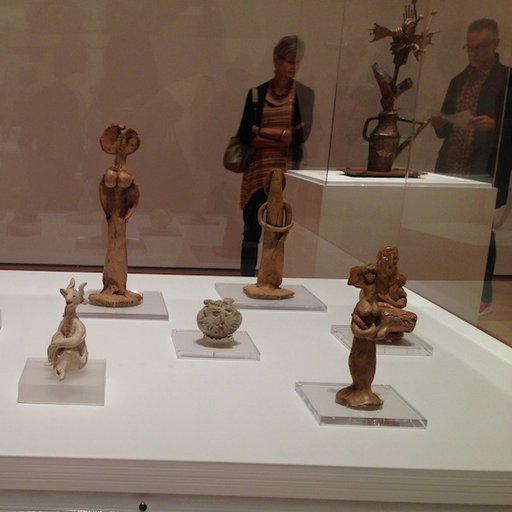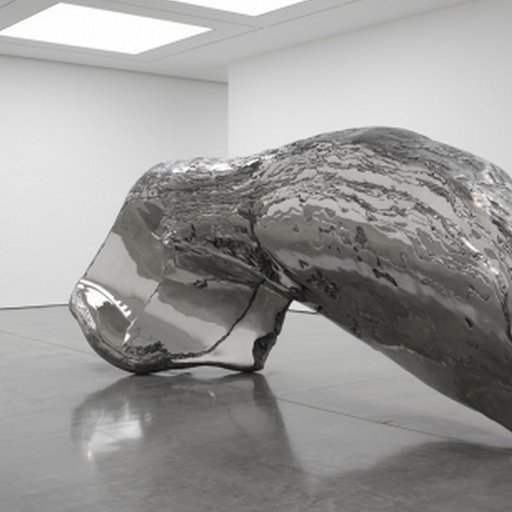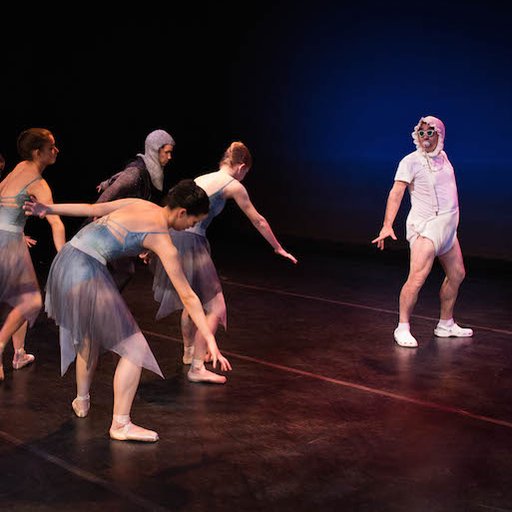The 2015 Istanbul Biennial covers a bewildering multitude of topics, as is expected of a Carolyn Christov-Bakargiev exhibition. But you could say that this Biennial, perplexingly titled "Saltwater: A Theory of Thoughtforms," is mostly about movement—the movement of people, currency, thoughts, time, ideas, animals, the sea, the sun, the planet, and so on.
To be more specific, you could also say that it’s about exile. One of the primary figures Christov-Bakargiev referenced in the months leading up to the exhibition and in her text is Leon Trotsky. Two of the works that have received the most press coverage, by William Kentridge and Adrian Villar Rojas, are also Trotsky-related.
Kentridge’s multi channel video installation O Sentimental Machine, references Trotsky’s time in Istanbul but fails to deliver the poetic sense of erasure that you expect from the theme and from Kentridge. Villar Rojas’s sculptural installation The Most Beautiful of all Mothers, in which majestic and enormous sculptures of pairs of animals evoke a capsized Noah’s Ark, is located on the shore of Büyükada Island near the mansion where Trotsky stayed in the late 1920s to early 1930s during his exile from Russia. The sculptures are beautiful and photogenic, but you wonder how much of their power derives from this spectacular setting.
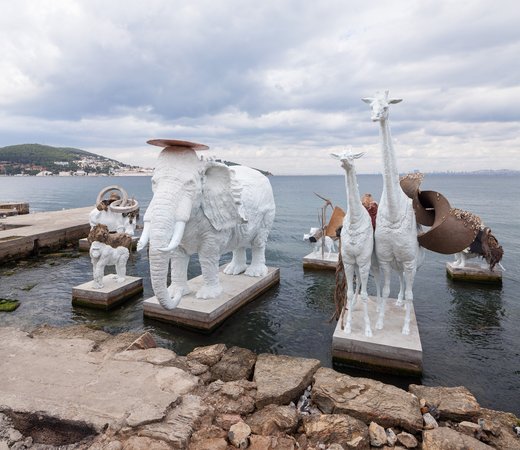 Adrian Villar Rojas's site-specific installation The Most Beautiful of All Mothers, 2015. Photo by Sahir Ugur Eren.
Adrian Villar Rojas's site-specific installation The Most Beautiful of All Mothers, 2015. Photo by Sahir Ugur Eren.
The Biennial also makes clear references to the Armenian genocide and the exodus of Turkey’s Greek population. One of the strongest works in this category is Francis Alys’s The Silence of Ani, an installation and video that highlights the disappearance of birds (the symbol of freedom) from the old capital of Armenia; it focuses on the instruments made by the remaining population in an attempt to call the birds back to their home. Equally relevant is a specific section of the Biennial dedicated to Australian Aboriginal art from the early 1900s to 2005, calling attention to the “exiling” of indigenous populations.
There are multiple, often contradictory ideas of exile at play throughout this Biennial: we see Turkey as a country that both takes in exiles (Trotsky) and expunges them (Armenians, Greeks, now the Kurdish people). This is what Christov-Bakargiev is talking about when she speaks of saltwater, which is both healing and highly corrosive.
But that is as close as she comes to confronting the current crises enveloping Turkey. Christov-Bakargiev consciously and meaningfully chose to avoid contemporary examples of migration, instead turning to history. Her heavy focus on the horrors of nearly a century ago can be seen as noble, but in practice it gives this biennial an orientalist slant; the show’s strictly retrospective diplomacy carries the whiff of Western privilege.
The theme of movement or exile is also a personal one for biennial-goers. The lengthy journeys between the exhibition’s over 30 venues, and the time required to see it all (at least two full days, if you’re moving quickly), makes Saltwater sometimes feel more like a Bosphorus tour than a biennial. If you don’t live here, and especially if you are coming from the West, it’s all too easy to romanticize Christov-Bakargiev’s efforts. The same even goes for residents of Istanbul, who are enjoying unprecedented access to some of the city’s most beautiful and precarious buildings during the event.
 Anna Boghuiguian's installation The Salt Traders, 2015. Photo by Sahir Ugur Eren.
Anna Boghuiguian's installation The Salt Traders, 2015. Photo by Sahir Ugur Eren.
Many of the Biennial’s works simply drown, either in their overwhelming settings or in Christov-Bakargiev’s heady curatorial vision. This happens in both the group shows in the four main venues (Istanbul Modern, Arter, the Galata Greek Primary School, and the Italian High School), and in solo outings in buildings that are far too interesting to let the work live and breathe. Fortunately, there are some memorable exceptions. One is Ed Atkins’s Hisser, a two-channel video with enough power to stand up to the intriguingly dilapidated Rizzo Palace on Büyükada; it tells the story of the last half-hour in the life of a man who fell into a sinkhole and was never seen again. The mansion shook as the video played, suggesting that another sinkhole might open up right there in the Palace.
Atkins addresses Christov-Bakargiev’s themes more elliptically and poetically that many of the Biennial’s other artists. (Unfortunately, his video had no Turkish subtitles). Theaster Gates also seems to have maintained his autonomy in his commissioned installation, Three or Four Shades of Blues, and his performance during the opening days of the biennial. He managed to float above Christov-Bakargiev’s waters by assimilating an authentically Turkish Iznik plate and placing it systematically and smartly within his own specific context.
 Ed Atkins's two-channel video installation Hisser, 2015. Photo by Sahir Ugur Eren.
Ed Atkins's two-channel video installation Hisser, 2015. Photo by Sahir Ugur Eren.
Kristina Buch’s two-channel video in a garage in Tophane, a neighborhood with a history of violence toward the art world’s attempts at gentrification, also asserts itself in the midst of the Biennial’s thematic pressures. Its two screens, set side-by-side, show the top of a mountain and the top of the Guggenheim in New York and are accompanied by a soundtrack of alarming explosions. The work is about the destruction of culture and nature, and offers a respite from the many works in the Biennial that have actual water and actual salt in them.
“Saltwater” also has a significant quantity of inaccessible or imaginary venues and works, which suit Christov-Bakargiev’s elusive thought process and style of exhibition making but contribute to the Biennial’s dangerous exoticism. Chief among them is Pierre Huyghe’s self-serving and impenetrable underwater stage, Abyssal Plain, located off the coast of Sivriada (an island associated, naturally, with exile).
Then there is the issue of the Museum of Innocence, Orhan Pamuk’s nostalgia museum, which is showing works by the Armenian-born Abstract Expressionist Arshile Gorky. The issue here is not the show, but the museum’s entrance fee (which makes it the only biennial venue to charge admission and seems generally inappropriate given Pamuk’s omnipresence in the biennial and its texts). It’s certainly a strange move by Christov-Bakargiev, who has shown outward aggression towards commercial art events like the fair Art International Istanbul. Also problematic is Pamuk’s status as a fundamentally western Turkish author, and one who is, like Christov-Bakargiev, interested in the past and in melancholy to the point of having tunnel vision where contemporary Turkey is concerned.
 Arshile Gorky's drawings Act of Creation, 1944, and Vale of the Armenians, 1947, in the Museum of Innocence. Photo by Sahir Ugur Eren.
Arshile Gorky's drawings Act of Creation, 1944, and Vale of the Armenians, 1947, in the Museum of Innocence. Photo by Sahir Ugur Eren.
In her introduction to the biennial’s catalogue, Christov-Bakargiev writes that salt and water are the two substances that all living organisms can detect. The irony is that Saltwater is not so universal, in this cross-species, primordial sense. In fact, it is hugely dependent on obvious references to water and salt, and on the cultivation of intellectual and imaginary landscapes.
Making your way through the show, you begin to realize that Christov-Bakargiev is more of a mad scientist than a curator. (In the catalogue, she calls herself a “draftsman.”) The only real way to unpack what she is trying to do is to read this volume, which looks like an old science book or maybe a Bible. It’s a hardcover with silk page-savers and small type, and is printed on the kind of paper that you immediately associate with didactic texts. While the pretension of the publication is off-putting and somehow aggressive, its content lives up to the fuss. The exhibition’s, on the other hand, generally does not.
The final section of the book’s introductory essay is called “the planet without a visa.” That title is a direct reference to writing by Trotsky, and to the Biennial’s ideas of movement. But it is also a utopian vision, and one that seems very far-fetched for Turkish citizens and others living in and passing through the region today. It exemplifies a Biennial that tries to be inclusive but is really alienating, saturated in Western entitlement, and difficult to see let alone understand.











